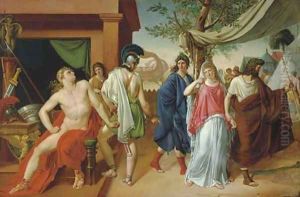Pierre-Edme-Louis Pellier Paintings
Pierre-Edme-Louis Pellier was a French painter and engraver born in 1793 in Paris. Though not as widely recognized as some of his contemporaries, Pellier made contributions to the French art scene, particularly through his work in portraiture and historical scenes.
Pellier's early life and training are not thoroughly documented, but it is known that he was active during a period of significant upheaval and change in France, encompassing the latter part of the Napoleonic era, the Restoration, and the July Monarchy. He would have been a contemporary of artists such as Eugène Delacroix and Jean-Auguste-Dominique Ingres, who were central figures in the Romantic and Neoclassical movements, respectively.
During his career, Pellier exhibited his work at the Paris Salon, the official art exhibition of the Académie des Beaux-Arts in Paris. The Salon was the premiere event for artists to gain recognition and attract patronage. Pellier's submissions to the Salon indicate that he was an artist of considerable skill, particularly noted for his ability to capture likenesses in his portraits.
In addition to portraiture, Pellier also engaged with historical subjects, which were popular at the time due to a burgeoning interest in national history and identity. His work would have been part of the larger cultural movement in France that sought to define the nation's past and present during a century marked by revolution and change.
Pellier's death occurred in 1852, a year that also marked the end of the Second French Republic and the beginning of the Second Empire under Napoleon III. While Pellier's work may not have achieved the same lasting fame as that of some of his peers, his contributions to the art of his time are a testament to the vibrant and diverse artistic milieu of 19th-century France.
